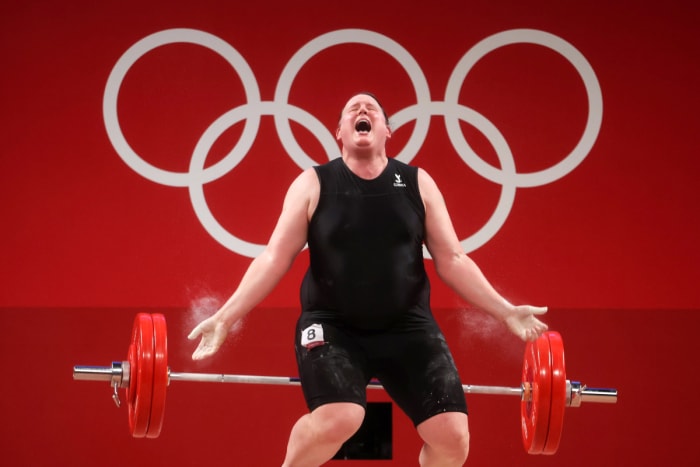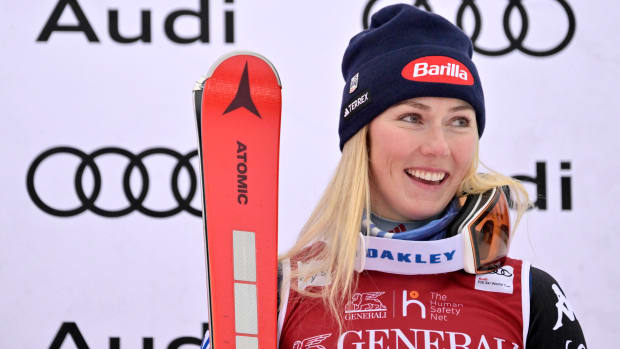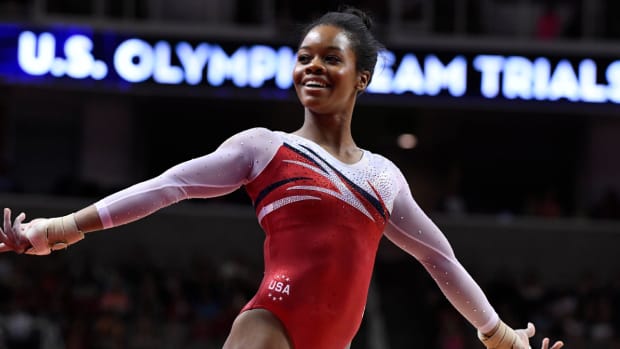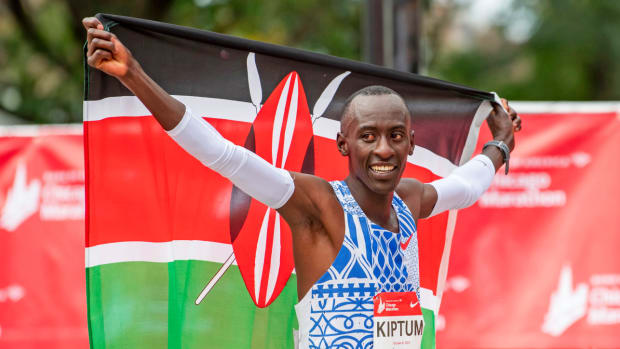The IOC Has a New Trans-Inclusion Framework, but Is the Damage Already Done?
Jenna Weiner started playing ultimate in 2011 as an undergraduate at Cal. She loved chasing down discs on long throws and the beauty and simplicity of seeing them in flight. So in ’16, when she started a graduate program in communication studies at the University of Nevada, Reno, it made sense that the sport she loved would help her find community in a new city.
Weiner, 28, had started her gender transition shortly before beginning graduate school that fall, and USA Ultimate had put a new transgender-inclusion policy in place over the summer. She continued playing men’s ultimate that fall, but decided to return for the spring semester and be completely out as Jenna. It was her first time trying to play collegiate women’s club ultimate.
To find out whether she was eligible, Weiner contacted USAU. She had already been on hormone-replacement therapy (HRT) for six months. “I was like, ‘Hey, what do I do? Can I play on this women’s college team? Or do I have to go through this year of testosterone [suppression]? Can I practice with the team if I don’t play tournaments?’”
Policies are designed to promote fairness in competition and (ideally) inclusion. But often, trans eligibility policies are created by people outside the trans community. They center the feelings of the cisgender competitors who may feel threatened by competing against a trans person rather than the feelings of the trans people like Weiner, who are often excluded or policed by them.
When Weiner was trying to figure out whether she was eligible to play ultimate in 2016, she felt like she was transitioning all alone. She didn’t know of other transfeminine voices in the sport, and she felt like her experience was valuable in demonstrating why USAU’s testosterone-based policy needed to change.
The policy of the USAU, and many other governing bodies at all levels of sports, is downstream of that of the International Olympic Committee. The IOC most recently updated its inclusion policies in 2015, and its focus on testosterone levels has trickled down to even youth sports in the United States. The IOC rolled out a new framework in March ’22 to encourage moving away from testosterone-based restrictions, but its former policy has already been used as a model for so many other leagues—with devastating consequences for trans athletes.
The IOC’s transgender-inclusion policy, until now, required all women to have testosterone levels under 10 nanomoles/liter and transfeminine people to be on testosterone-supressing medication for at least a year. It was more scrutinized during the Tokyo Games in 2021 than it had been at any point since it had been put in place six years before. That was due to the participation of the first openly trans woman, New Zealand weightlifter Laurel Hubbard, and two cisgender female Namibian runners’ being deemed ineligible due to their testosterone levels.
The IOC’s new trans-inclusion framework was three years in the making and officially rolled out following the Winter Olympics in Beijing. It was a complete reversal from the group’s previous stance. It places the responsibility of establishing guidelines for trans inclusion on each individual sport. It also concludes that sporting bodies should not assume that transgender women have an inherent advantage over cisgender women, nor should transgender women have to reduce their testosterone levels to compete.
The new framework was informed by conversations with stakeholders from across the sports world, as well as legal and medical experts. Importantly, the IOC also acknowledged that its previous policy caused real harm to the well-being of trans athletes around the world.
“A lot of sport governing bodies at both national and grassroots levels will look to the IOC to set standards,” says Anne Lieberman, the director of policy and programs for Athlete Ally, one of the many organizations the IOC consulted when developing its new framework. “But I don’t think that until they were sitting in front of athletes and hearing from other organizations working in the space, [they realized] just how wide-reaching an impact their guidelines are having.”
The IOC’s drastic shift is a massive step forward in terms of what true inclusion for trans athletes at elite levels of sport can look like. But is the new framework too little, too late to fix the negative impact the IOC’s previous guidance has had on sports? And is this framework, which has no mechanism for enforcement, doing enough to change the existing narrative around whether—and how—trans athletes should get to play sports?

“The relationship between the IOC and the international federations goes right down to local sport,” Worley (left, alongside golfer Mianne Bagger) has said.
Don Arnold/Getty Images
In 2015, the International Olympic Committee made new rules that, at first glance, expanded trans athletes’ rights. Since ’03, the IOC had allowed trans athletes to participate in the Olympics, but only if they had undergone complete gender reassignment, including genital surgery. After a Canadian cyclist named Kristen Worley sued the IOC, claiming those rules were a human rights violation, the IOC revisited its policy and came out with significant new guidelines—guidelines that would inadvertently define the playing field for women, intersex and trans athletes for years to come.
The 2015 rule offered a more welcoming stance to transfeminine athletes: Trans women who had been on hormone replacement therapy for at least 12 months would be allowed to compete in the Olympics against other women. That was based in part on recently published—but very limited— research that showed HRT did not make trans women more competitive in women’s divisions than they had been in men’s. The new policy meant the requirements for genital surgery were gone. This mimicked, in most ways, the NCAA policy that had been in place since ’11 for championship events. (The NCAA’s policy required HRT but did not measure hormone levels.)
The testosterone level of 10 nanomoles/liter, which so much sport participation has come to hinge on, doesn’t actually mean anything, and one study called it “untenable.”
Even the 2015 paper used to create the IOC’s trans inclusion policy was never meant to be applied as widely as it has been. The study was small—only eight athletes, all runners. Its author, Joanna Harper, a nationally ranked long-distance runner, had started tracking data based on her own transition. She was invited to be part of the meeting where the new trans-inclusion policy was being discussed—the first trans woman to be part of these conversations and the only trans woman in the room of 20 people.
Looking back, Harper, author of Sporting Gender and a Ph.D. candidate at Loughborough University researching trans athletes, stands by the policy put in place that year. “No policy is perfect, and trying to decide what to do with trans athletes is an incredibly difficult thing from a policy point of view,” she says. “At the time, I thought it was a reasonable policy. I still think that the principles behind it are good.”
But the impact of the IOC’s testosterone-based, exclusionary inclusion policy has touched every level of sport, something that Worley warned about in her 2015 lawsuit. “In terms of the policies behind what we’re doing, we’re showing the relationship between the IOC and the international federations goes right down to local sport,” Worley told the Sports Integrity Initiative at the time. “The impact of gender and gender policy is felt throughout sport in every country within accredited Olympic sport.”
According to the Olympic charter, it is the international federations (IFs) that define the eligibility of athletes in their sport. But for many elite international athletes, the ultimate goal is the Olympics, and having a different policy from the IOC’s can complicate matters. Many of the federations, including British Rowing, Cycling New Zealand, USA Climbing, USA Curling and USA Ultimate, explicitly cite the IOC’s 2015 policy in their own or say they will default to the IOC’s for international competition.
Now, with the IOC’s new framework in place, there is no longer a default policy that IFs can look to for guidance; they must come up with new ones for their sports on their own. There is no timeline for those policies to be put in place, and, until they are, the existing ones will remain enforceable.
“When we’re looking at elite-level sports, there is this connection to the IOC policy and this feeling that organizations need[ed] to align with the existing elite policies, because going far away from the Olympic policy puts organizations at risk for scrutiny or pushing the boundaries too much,” says Chris Mosier, a trans duathlete and the founder of TransAthlete.com. He has been tracking trans-inclusion policies since 2013 and has consulted on dozens of them.
Even with the IOC now recommending that there should be no required testosterone levels for women to compete, some federations, like World Athletics, have said they have no intention of changing their existing policy—and the IOC’s new framework has no requirement that they do so.
The NCAA recently released a similar update to its policy, in which the individual sports are responsible for determining eligibility. In response, USA Swimming updated its guidelines to be more restrictive, requiring testosterone levels of 5 nmol/L, as well as 36 months of testosterone-suppressive medication, for transfeminine athletes to be eligible to compete in the women’s division—the longest wait time of any sport governing body internationally.
These modifications came down midseason, which some people interpreted to be in response to pushback regarding Penn swimmer Lia Thomas. An NCAA committee decided against imposing the new restrictions immediately—however, it said that Thomas (or any trans woman) must have testosterone levels below 10 nmol/L. And the testosterone-based arguments are continuing to be used for exclusionary purposes. In an op-ed for The Washington Post in which she argues that Thomas should not be able to swim against women, former swimmer Diana Nyad cites the fact that “sports authorities have for decades judged fairness by testing testosterone in both men and women.”
The IOC’s blueprint extends far beyond federations. Professional leagues in North America, like the National Women’s Soccer League and Athletes Unlimited, have testosterone-based policies like the IOC did. The NWSL released its policy last year, on the Transgender Day of Visibility, and it was immediately panned as archaic and out of touch with the current conversation around trans inclusion.
It includes the 10 nmol/L requirement for testosterone levels, as well as being on hormones for at least 12 months. NWSL general counsel Lisa Levine has told the women’s soccer website All for XI that the league looked at the IOC’s 2015 policy while developing its own. These policies consider testosterone to be a performance-enhancing drug, and while the NWSL’s policy has a therapeutic use exemption for transmasculine athletes to use low levels of T for gender-affirming reasons, it requires that “the athlete’s total testosterone level … is within typical limits of women athletes,” bringing us back to that 10 nmol/L number.
The new professional league Athletes Unlimited, which fields softball, volleyball, lacrosse and basketball, has a testosterone-centered policy in place that requires transfeminine athletes to be taking testosterone-suppressing medication, but it doesn’t specify how long they need to be on those medications, nor does it require a specific testosterone level.
“This policy was created to acknowledge all forms of gender expression, to be respectful of athletes’ privacy and not require invasive disclosure, and to honor an athlete’s right to self-assess their own eligibility to play in our leagues,” a spokesperson for AU told Sports Illustrated. “Given the long history of policing women’s bodies in sports, we wanted to explicitly depart from the problematic business of determining what constitutes a ‘normal’ or ‘typical’ woman in any respect and especially with respect to hormone or testosterone levels.” That may be the intent, but the league still requires transfeminine athletes to take medication to suppress testosterone levels to compete, so it is, to some extent, policing who gets to compete as a woman.
Compare that to the Premier Hockey Federation, which was the first U.S. professional league to have a trans-inclusion policy. It went into place in 2016 when Buffalo Beauts player Harrison Browne socially transitioned as a trans man. In October, the league implemented an updated policy that removed all hormone requirements for transfeminine athletes—the first pro “women’s” league to do so (though it put a requirement that trans athletes be “living in their identity” for two years before being eligible for the league, a guideline that has been criticized as transmisogynist). Most policies are, at best, imperfect.

In a move advocates say was targeted at Thomas, a trans swimmer at Penn, USA Swimming recently its eligibility policy to be more restrictive, requiring testosterone levels of 5 nmol/L, as well as 36 months of testosterone-suppressive medication, for transfeminine athletes.
Donald Miralle/Sports Illustrated
In March 2017, Weiner came out to the ultimate community in an article in SkyD Magazine. “It was worth it to me to share my story,” she says. “And the reception to the article was what shocked me into realizing that this was important.” It was also the beginning of USAU’s path to implementing a trans-inclusion policy that worked for all its athletes, and one that other leagues and governing bodies could learn from, rather than one that had similarities with the IOC’s old policy. But most leagues have not been as forward-thinking as USAU.
Weiner did have to wait six more months to start playing, which was incredibly difficult for her. “I was stuck in this limbo,” she says, “because I was a player on the team but I can’t play tournaments.” But the IOC had set the standard, and USAU was just mimicking it at a lower level of competition.
Further down the competitive ladder, youth sports aren’t immune from these ideas, either. Testosterone-based inclusion policies aren’t direct antecedents to the anti-trans bills that have been introduced in more than 30 states (and enacted in nearly a dozen) trying to ban trans girls from competing in girls sports (and sometimes, but less frequently, trans boys competing in boys sports), but there is connective tissue. Many of the bills are based on a specious assumption that boys have an inherent biological advantage over girls when it comes to athletics.
“Even though most of the state-level bills are focused on middle school and high school, you still see rhetoric and misinformation about Olympic standards for trans athletes and athletes with intersex variations make it into some of these conversations, even though they are entirely different levels of sports,” says Lieberman.
While most of these bills do not require hormone-level tests, many could require invasive genital exams or the release of children’s private medical records. When elite trans athletes are put under such extreme scrutiny, it affects kids at even the lowest levels of sports.
“If I’m not allowed to play soccer for a girls team, and I am a girl, and you don’t support that, you're not respecting the freedom of rights,” says a 10-year-old trans girl from Arizona who plays soccer. We’ll call her Jane.
Jane told her teammates that she was trans when it came up naturally in conversation. The girls were discussing a transgender makeup artist they loved watching on YouTube, and Jane used the opening. “Then she said, ‘That’s pretty cool,’ and they moved on,” Jane says.
A bill in Arizona was just approved by a Senate committee this month that would bar trans girls from competing in girls sports. Vanessa Anspach, Jane’s mother, says she worries about the way her child will be impacted if the bill passes. “We would certainly consider moving somewhere else,” she says.
This line of thinking—comparing children’s bodies to those of elite athletes—didn’t emerge until recently, says Chase Strangio, the deputy director for transgender justice at the American Civil Liberties Union. “There are currently no policies at the scholastic level in the United States that require some sort of measure of hormonal testing,” he says.
Still, the IOC’s policy is omnipresent—the lawyers who fight for transfeminine athletes sometimes have to make arguments based on the IOC’s 2015 guidelines. In the short term, this may allow trans girls to compete, as it has with 11-year-old Becky Pepper-Jackson in West Virginia. In a ruling filed July 21, 2021, Judge Joseph R. Goodwin wrote that Pepper-Jackson’s lawyers had “provided evidence that any physical advantages that men and boys enjoy are derived from higher concentrations of circulating testosterone” and cited that as being supported by the NCAA policy and the IOC policy (both of which have since been updated). Therefore, since Pepper-Jackson is on puberty blockers to delay her testosterone-driven puberty, she should be considered “just like other girls” from a biological standpoint.
Codifying testosterone-based science as the true indicator of who is eligible to be considered a girl sets a precedent in which womanhood is continuing to be policed—and risks setting up a binary of “nonthreatening” trans girls who transitioned before testosterone-driven puberty began and “threatening” trans girls who transitioned at a later point in life.
“I would say that all of our litigation runs the risk of entrenching medicalized standards for athletics and the application of equality norms for trans people that presume some level of medical transition or requirements,” Strangio says. “But also, if you’re representing your client, you have to represent them as effectively, with the best arguments, that you can. And so if you have a client who’s medically transitioned, and they’re arguing things that are antithetical to the notion of someone who’s been on blockers, it would be malpractice not to point out the arbitrary nature of those arguments.”
We already see that occurring with groups like the Women’s Sports Policy Working Group, composed of several former Olympians, including Martina Navratilova and Nancy Hogshead-Makar. (Nyad is also a supporter.) They have offered what they see as a “middle ground” proposal for allowing trans girls to compete in interscholastic girls sports, and it involves having T levels under 10 nmol/L. The 2015 IOC policy has come to be seen as a reasonable place to settle.
“High school is where Title IX does most of its work,” a spokesperson for the group wrote in an email to Sports Illustrated. (The Biden administration has affirmed that Title IX protects transgender students, as well as cisgender girls, from discrimination.) “Given this, it made sense to borrow the Olympic Movement’s approach, not because elite sports standards should automatically apply to school sport but because they’ve done the scientific and ethical work necessary to understand how to include transgender athletes in girls and women’s sport [in] a way that’s not category defeating.” (The group did not respond to several requests for comment on whether their policy stance has changed along with the IOC’s new recommendations.)
The group also wrote that “harmonizing the eligibility standard across sports settings ensures that school sport can continue to serve as the most important incubator for Team USA.” This is where we see another trickle-down effect: the idea that scholastic sports should be preparing athletes for elite competition. But “that’s not what school is for,” says Victoria Jackson, a sports historian and clinical assistant professor of history at Arizona State. “The original intent and interpretation of Title IX focused on equal opportunity and this idea that sport is educational, that all students have a civil right that is to be protected. There’s nothing about Title IX that’s protecting the right to win or to be elite in sport.”
Which is why even the WSPWG’s collaborators see issues with its approach. Harper is one of three trans women listed as a supporter on the group’s website. However, she does not agree with its proposal to apply elite, international, hormone-based standards to high school athletes. “If I were making high school policy, I would suggest something different than what this group has done,” Harper says. “Different levels of sport should require different rules. I certainly think that at recreational levels of sport, and at some level between recreational and national level, we should just be letting people play.”
While on the surface, what we are seeing is an importation of elite athletic policies at the K-12 level, what is actually happening is an increasing desire to cede to the government—or executive entities like the NCAA or an international sporting federation or the IOC—the power to control people’s bodies and scrutinize who is sufficiently “female” to allow them to participate in the category of girls and women’s sports. That is the core idea behind every trans inclusion policy, and until now, it was reinforced by the IOC.

Hubbard was the first openly trans woman to compete in the Olympic Games.
Chris Graythen/Getty Images
While over the years an increasing number of leagues and governing bodies have moved closer to the IOC’s 2015 policy, some began to shift away from the model even before the committee itself shifted away from it with the announcement of its new framework. As anti-trans rhetoric has increased and trans athletes have been targeted by discriminatory legislation in the United States, sporting federations have realized that they have to do more research into the issue.
Mosier has been tracking trans-inclusion policies since 2013. He says the biggest change he’s seen is the number of governing bodies that have adopted trans-inclusion policies at all levels of sport. When he started keeping track, there were hardly any.
Some leagues, like USA Ultimate, that—faced with evidence that testosterone levels being used as the barometer to qualify someone to compete in the women’s division are arbitrary—went in a different direction long before the IOC’s recent pivot. After Weiner wrote her piece for SkyD, USAU put an updated policy in place. It was similar to the IOC’s 2015 policy. But just a year later, USAU decided to revisit it. Its new policy, which went into effect in December ’20, is one that centers the experience and safety of the league’s trans athletes. The policy allows for athletes to self-identify the division they want to play in, no questions asked, in North American competitions.
“We looked at—and then pretty quickly discarded—other policies that exist,” says Kellan Gibboney, a community liaison and gender equity consultant for USA Ultimate who helped develop the new policy. The International Quidditch Association has a similar policy.
USA Ultimate’s goal was for everyone to be able to play in whatever way felt safest for the athlete. Ultimate is huge at the collegiate level, and asking transfeminine players to wait a year after beginning hormones to participate meant they lost at least a year of eligibility in an already short window of time. Transmasculine athletes taking low doses of T may not feel safe on a field with cisgender men. And then there are the barriers to transitioning—the cost and access of hormones and/or surgery, the costs and paperwork associated with changing one’s gender on their official documents and even the cost of having hormone levels tested. USA Ultimate did not want any financial barriers or access issues to impede someone’s ability to play.
“I think that we’ll see baby steps away from the IOC policy in the way that people are talking about testosterone,” says Mosier. “But I think so many people believe that testosterone science is the best way to make a policy at the elite levels for events right now because of the IOC policy. It’s going to take a while before we see people really try to spend some time reimagining what sport might look like and how we write our policies.”
It remains to be seen whether the IOC’s new framework will be too little, too late. Without teeth to force any governing bodies to adopt inclusive policies and with the conversation around trans inclusion already so mired in scare tactics and bad science around testosterone, it may be years before a truly trans-centered model of inclusion like USA Ultimate’s finds its way to the wider world of sports. It is trans athletes who will continue to suffer.
Meanwhile, any forward progress that is made will happen despite the IOC, not necessarily because of it. It will happen because of people like Weiner, whose experience researching and advocating for a better, more trans-centered policy for USAU ended up shaping her career path. She now works as a research fellow for Athlete Ally, where she can have an even larger impact on shaping the trans-inclusion policies of the future.
“It’s individual people that end up pushing the policies forward in one way or another,” says Weiner. “This is not to pat myself on the back, but to give credit to every trans athlete out there, across all the different sports, who is pushing these things forward.”
More Transgender Athlete Coverage:




